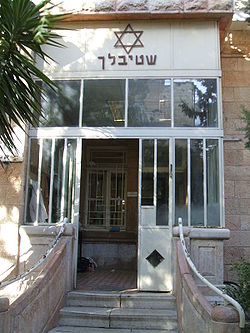Shtiebel
This articleneeds additional citations forverification.(May 2017) |

Ashtiebel(Yiddish:שטיבל,romanized:shtibl,lit. 'little room or house', pl.שטיבעלעךshtibelekh) is a place used for communal Jewish prayer. In contrast to a formalsynagogue,a shtiebel is far smaller and approached more casually. It is typically as small as a room in a private home or a place of business which is set aside for the express purpose of prayer, or it may be as large as a small-sized synagogue. It may or may not offer the communal services of a synagogue.
Traditional shtiebels are not only a place forprayer,but also a place for community gathering. Due to the prominence of a Hasidicrebbe,the shtiebel served as a medium for being near to him. A shtiebel would be host to theshaleshudes,the ritual third meal ofShabbat.The shtiebel attracted newcomers through the inviting atmosphere it created by allowing prayer, eating, drinking, and community activities.[1]
Shtiebels were common in Jewish communities in Eastern Europe beforethe Holocaust.The shtiebel was distinctly characteristic of Hasidic Judaism and played a central and critical role in the life of theHasidim.[1]It continues to exist in contemporaryIsraeland theUnited States.
The shtiebel was cost effective and assisted in the spread of Hasidism through agrassrootsmovement where individuals previously exposed to Hasidism could establish one in their local community. This characteristic of the shtiebel allowed for Hasidism to reach more communities on the local and regional level throughout the 18th and 19th Century.[1]
In Israel,minyansare held in storefrontshtiebelekhin major business areas around the clock; whenever ten men show up, a new minyan begins. The Zichron Moshe shtiebel in theZikhron Mosheneighborhood ofJerusalem(nearGeula) is located in a propersynagogue,with many rooms for round-the-clock minyans. This shtiebel is well known as the locale of Friday-nightmussartalks which RabbiSholom Schwadron,the "Maggidof Jerusalem, "delivered for more than 40 years.
Shtiblach in its current meaning
[edit]In the ultra-Orthodox community in Israel, synagogues developed in which several rooms (shtibelekh) were concentrated to prayerminyanim.The purpose of the shtiblach is to allow a parallel prayer place and a more liberated atmosphere. Unlike a synagogue in which there are regular prayer times, certain seating arrangements, and the like, the Shtiblach operates at all hours of the day and routinely includes temporary worshipers.
